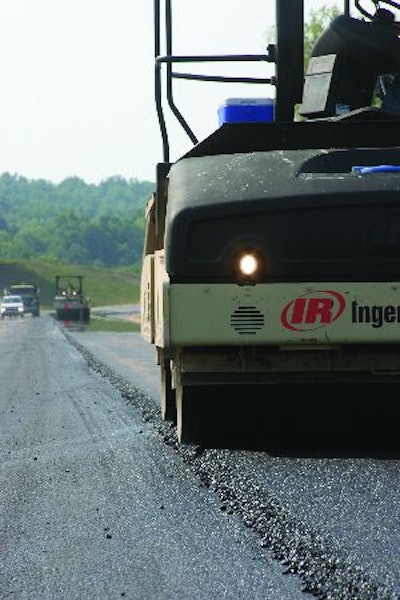
With increasing volumes of traffic on aging highways, the repair and construction of new roads is more critical than ever. One state taking the lead in trying to get ahead of this problem is Kentucky.
"The Kentucky Transportation Cabinet is pushing forward with the most aggressive highway improvement program in Kentucky's history, investing more than $1 billion in highway construction in 2006," says Mark Brown, a public information officer with the Kentucky Transportation Cabinet. "The state is on track to surpass that figure in calendar year 2007."
There are many high-profile projects going on in the state, including Restore 64, which is making improvements to Interstate 64 through downtown Louisville; a project rehabilitating the Hwy. 61 twin bridges over the Ohio River in Henderson, KY; and the Heartland Parkway, a long-term project to improve the road that connects the Martha Layne Collins Bluegrass Highway and the Louie B. Nunn Cumberland Parkway to provide better access to Kentucky's Central Lakes region.
Another project, just north of the Heartland Parkway plan, is near Taylorsville Lake and is an extension of Kentucky Hwy. 555.
"The purpose of the extension is to provide better access for central Kentucky to the Louisville area, the Martha Lane Collins Bluegrass Parkway and other area roads," says Brown.
The Kentucky Hwy. 555 extension begins at the Martha Lane Collins Bluegrass Parkway in Washington County and proceeds north, touching the southeastern tip of Nelson County before entering Anderson County. It continues to the northeast, following Love Ridge Road and U.S. 62 before crossing U.S. 62 near Johnsonville. From there, the extension goes north to Kentucky 248, which takes it to Taylorsville Lake. The project is seven miles long.
"Extending Kentucky 555 will improve transportation accessibility and efficiency to the area," says Brown. "It's going to create growth in the number of visitors to the east end of Taylorsville Lake and provide opportunities for economic development to the area. It will have a positive impact on education and public services by providing safer and quicker routes for school buses and emergency vehicles."
Of the over $1 billion being spent on road construction projects in Kentucky in 2007, $36.5 million is allocated to the Hwy. 555 extension. The project was introduced into the state's six-year highway plan in 1992. Preliminary engineering and environmental impact studies were begun in 1994.
While this may seem like a long time for a project to come to fruition, Brown says that the Hwy. 555 timeline is normal.
"The Kentucky Six-Year Highway Plan is formulated and approved by the general assembly and signed and executed by the governor and the Kentucky Transportation Cabinet," says Brown. "Just because a highway project is in the six-year plan doesn't mean that it's going to have a six-year lifespan. Other priorities can come up and circumvent any particular project. The timeline for the Hwy. 555 extension is not out of the ordinary."
Mago paves the way
The company contracted to pave Kentucky Hwy. 555 in Nelson County is Mago Construction Co., based in Bardstown, KY. "We're family owned and have been in business for 50 years," says Chris Edelen, equipment manager for Mago. "We have 11 asphalt plants and two stone quarries. We primarily supply our own materials and we run five paving crews."
Another contractor completed the grade work on Hwy. 555 and Mago is doing the paving. "The grading contractor prepares a mile to a mile-and-a-half at a time for us," says Mike Mattingly, paving supervisor for Mago. "We lay rock on the mainline and then pave asphalt. We lay the mainline base lifts and then pave rock on the shoulders again so the trucks can get off it. We alternate back and forth."
Mago uses a Volvo Blaw-Knox PF-5510 to lay the rock. Volvo Construction Equipment purchased the Ingersoll Rand road development division on April 30, 2007. A total of 130,000 metric tons of rock is being placed at the jobsite. Mago averages 2,500 tons of crushed stone per day.
Edelen says that laying rock through a paver is not ideal because it can be rough on the machine, but is a necessary way of doing business today. "It's a costly way to lay material, as far as maintenance, but it's less costly than putting the rock down conventionally, which would require a Jersey box," he says. "If you use a Jersey box, it takes three to five days to lay the rock. But, if the sub-grade is correct, you can lay the rock through a paver one time and pave on it within two days."
When rock is laid through a paver, Edelen knows that his maintenance crew must pay close attention to the maintenance schedule for that machine. "We have to work double to keep up on the maintenance. With the old technology, running the amount of rock through a paver we're laying on the Hwy. 555 project would require us to put a new set of bearings on the paver every month," he says. The bearings last longer on the new pavers, but the abrasiveness of the rock still requires an accelerated maintenance schedule for the machine.
Mago is using a new Volvo Blaw-Knox PF-6160 wheeled paver to place the asphalt base. The PF-6160 is part of a recently introduced line of highway-class pavers from Volvo.
"We were in the market for a new paver," says Edelen. "We wanted to have a wheeled paver because we use our pavers on everything from highways to parking lots. We had bought another wheeled paver previously, a PF-3200, and the PF-6160 was the next step up, a high capacity machine."
Mago has been using Blaw-Knox pavers since the late 1980s. "We prefer to stay with one brand for our paving equipment because it makes for a more streamlined operation," says Edelen. "That way, the crews know what they're going to get when we send a paver or compactor to a job. When you go with one brand and one dealer for support, it streamlines your operation."
Kentucky Hwy. 555 is the second large job that Mago is paving with the PF-6160. The paver helped the company achieve a bonus on a job on Hwy. 90 in Williams County, Kentucky. Mago expects the PF-6160 will help achieve a rideability bonus on the Hwy. 555 project.
Mago is paving 50,000 metric tons of base this year in three lifts. The first base lift is 3.25 inches and the other lifts are three inches.
All of the asphalt is Superpave PG 64-22 and is produced at the Mago asphalt plant in Lawrenceburg, which is 45 minutes from the jobsite. "We like to run 20 trucks, but some days we can only get 13," says Mattingly. "The number of trucks we can get for a day affects how much asphalt we can put down, but we're averaging 2,100 tons a day."
The right equipment makes a difference
Mattingly likes the independent control of the auger and conveyor on the new paver. "The separate sonics on the auger and conveyors is the best thing they changed on the paver," he says. "You can make your conveyors and your augers move your material exactly like you want them to. As long as you stay at the paver speed you set, those augers and conveyors will run perfectly all day long."
The PF-6160 has an electrically heated Omni 318 screed. The crew turns the screed on at the start of the day and once they are consistently running asphalt through it they turn it off. It is turned back on if needed. The asphalt is placed between 285 and 290 degrees. The center joint is offset by six to 12 inches on each layer of base to create a more stable road.
Mago uses a Volvo DD-118HF as the breakdown compactor and a Volvo DD-110 as the finish compactor. Both compactors use vibration and make three passes over the mat. "With the temperature and humidity out here, the tender zone changes a little bit," says Mattingly. "The finish compactor has to stay out of the tender zone or the asphalt will start rolling up."
Once the paving of the base is completed, Mattingly's crew will move on to another job. Paving the surface layer, 16,000 metric tons in total, will take place this coming spring. The surface work will include approaches and driveways along the highway. Mattingly says that if the weather cooperates, the surface work will take three weeks and the highway will open in the early summer.
The Kentucky Transportation Cabinet has estimated that an average of 2,000 cars will use the new highway each day, with that number increasing to 2,200 cars per day in 2014.
"We have more construction under way than ever before in the history of the commonwealth," says Brown, of the Kentucky Transportation Cabinet. "Folks are seeing the improvements happen before their very eyes." ?
From flagger to operator
While women are still a minority in construction, they are well represented on the Kentucky Hwy. 555 jobsite. Of the six people working at the site, two are women, including Tabitha Ford, the paver operator. Ford is in her third paving season with Mago. Her first year, she worked as a flagger and the next year she moved to the paver screed. "She was determined to run equipment," says Mattingly. "She came to me and said, 'I don't want to flag anymore. I want to pave.'"
Mattingly appreciated the initiative Ford took. Since he makes all his operators work their way up on the crew, he started her on the screed the next year. Ford has received all her training on the job.
"I'm never really satisfied and I want to learn something every day," says Ford. "You can't help but learn something, because every day brings new challenges. I like the work and I think this is a great job."
In addition to being trained on the job, Mago sends crew members to the Volvo Road Institute. The Volvo Road Institute offers courses in operation and maintenance for paving and compaction equipment. "We send new people who want to move up in the crew to the Road Institute," says Edelen. "The courses help the crew members understand the machines they are working with. If they understand how the machine is supposed to work, they can make it function properly, which is critical in getting the job done right."
Ford also operated the PF-6160 on a job on the Martha Layne Collins Blue Grass Parkway. "There are two things I really like about this paver," she says. "The speed limiter helps you pave consistently and I like how the operator's seat slides out to give me a better view."
Eric Morse is a writer for Two Rivers Marketing, which provides marketing support to Volvo Construction Equipment of Shippensburg, PA. He can be reached at [email protected]










![Hcm Ax Landcros Dual Branded Logo[25]](https://img.forconstructionpros.com/mindful/acbm/workspaces/default/uploads/2025/11/hcmaxlandcros-dual-branded-logo25.Qhg3vUCjoK.jpg?ar=16%3A9&auto=format%2Ccompress&bg=fff&fill-color=fff&fit=fill&h=135&q=70&w=240)




